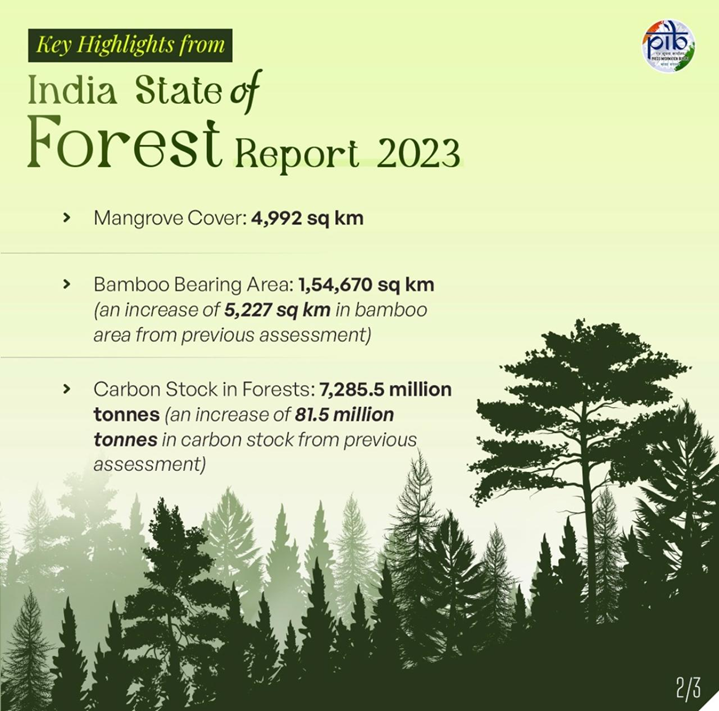Minister for Environment, Forest and Climate Change, Shri Bhupender Yadav released the ‘India State of Forest Report 2023 (ISFR 2023) at Forest Research Institute, Dehradun. The ISFR is brought out by the Forest Survey of India (FSI) on a biennial basis since 1987. FSI carries out in-depth assessment of the forest and tree resources of the country based on interpretation of Remote Sensing satellite data and field based National Forest Inventory (NFI), and the results are published in the ISFR.
India State of Forest Report 2023
Why In News
- Minister for Environment, Forest and Climate Change, Shri Bhupender Yadav released the ‘India State of Forest Report 2023 (ISFR 2023) at Forest Research Institute, Dehradun. The ISFR is brought out by the Forest Survey of India (FSI) on a biennial basis since 1987.
- FSI carries out in-depth assessment of the forest and tree resources of the country based on interpretation of Remote Sensing satellite data and field based National Forest Inventory (NFI), and the results are published in the ISFR. The India State of Forest Report 2023 is 18th such report in the series.
What Does Report Contains
- The report contains information on forest cover, tree cover, mangrove cover, growing stock, carbon stock in India’s forests, instances of forest fire, Agroforestry, etc. To present a detailed picture of the forest health at country level, special thematic information on forest cover and important characteristics of forests have been reported in the ISFR.
- As per the present assessment, the total Forest and Tree cover is 8,27,357sq km, which is 25.17 percent of the geographical area of the country. The Forest Cover has an area of about 7,15,343sq km (21.76%) whereas the Tree Cover has an area of 1,12,014 sq km (3.41%)
Forest Cover & Tree Cover
- Forest Cover is defined as follows: “All areas with tree cover having canopy density of greater than or equal to 10% and having an area greater or equal to 1 hectare.” It may be situated in recorded forest, or on other Government, private or Institutional lands.
- Tree Cover is defined as follows: “Tree Cover includes Woody vegetation Resources in patches and individual trees outside the RFA on blocks of less than one hectare.”
Report Highlights
- Increase in Forest and Tree Cover : Total forest and tree cover together have gone up by 1,445 sq km from the condition recorded in the previous year assessment and it includes 156 sq km of forest cover and 1289 sq km of tree cover.
- Top States with Maximum Increase : Chhattisgarh had the highest additional forest area of 684 sq km adding to the list is Uttar Pradesh with 559 sq km Odisha with 559 sq km and Rajasthan with 394 sq km.
- States with Largest Forest and Tree Cover: Among the states, Madhya Pradesh has the largest area under forests and trees 85,724 sq km, Arunachal Pradesh( 67,083 sq km), Maharashtra (65,383 sq km only).
- States with Largest Forest Cover: The highest forest cover in the country is reported by the Madhya Pradesh at 77,073 Sq km, second largest in Arunachal Pradesh at 65,882 Sq km and the third largest in Chhattisgarh at 55,812 sq km.
- Forest Cover as Percentage of Geographical Area: Among the states, Lakshadweep has the highest percentage of forest cover with 91.33%, second by Mizoram at 85.34% and third by Andaman & Nicobar Islands at 81.62%.
- Thus, presently, 19 states/UTs have more than 33 % of the geographical area under the forests, out of them eight states having the forest cover more than 75%.
- Mangrove Cover: Total Mangrove cover in India: 4,991.68 sq km or 0.15% of the geographical size of the country.
- Breakdown of Mangrove cover: Very Dense Mangroves: 1,463.97km² of the total area with 29.33% of cover.
Moderately Dense Mangroves: 1,500.84 km² (30.07%).
Open Mangroves: 2,026.87 km² (40.60%). - Change in Mangrove cover: It is still lower by 7.43 KM² from the total area assessed in 2021.
- Regional changes
- Andhra Pradesh: Expanded by 13 sq km because of the natural regeneration and planting campaigns, as well as preservation in Krishna, Bapatla, and Kakinada districts.
- Maharashtra: Grown by about 4506 hectare because of natural reproduction and state managed plantation schemes particularly in Raigarh and Palghar region.
- Gujarat: Decreased by 36 km²
- Growing Stock : The assessed total growing stock of forest and trees outside forests is 6,430 million cubic meters, which is 262 million cubic meters higher than in the previous assessment.
- Total growing stock: 6,429.64 M m³ total growing stock.
- An estimated 4,478.89 M m³ was filled inside Reserved Forest Areas (RFA).
- Outside RFA (TOF) was $1,950.75 M m³.
- Increase in growing stock: Total increase: 262.Central: 32 M m³ (4.25%) less in comparison with ISFR 2021.
- Increase inside forests: 90.92 M m³ (2.07%).
- Increase outside forests (TOF): 171.40 M m³ (9.63%).
- Bamboo Bearing: The actual area under bamboo in India is 1,54,670 sq km, the growth having been recorded at 5,227 sq km.
- Timber Production: TE-produced trees outside the forests contributed to a potential annual timber yield of 91.51 million cubic meters.
- Carbon Stock : The carbon pool stock of Indian forests is about 7,285.5 million tones and this has enhanced to 81.5 million tones than last assessment.
- By now, India accounts for a total carbon stock of 30.43 billion tones of CO2 equivalent, which in fact means, it is well on course to achieve its intended 2.29 billion tonnes of additional carbon sinks by the year 2030.



























